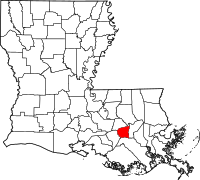St. James Parish, Louisiana
| Saint James Parish, Louisiana | |
|---|---|
 Location in the U.S. state of Louisiana |
|
 Louisiana's location in the U.S. |
|
| Founded | March 31, 1807 |
| Named for | Saint James |
| Seat | Convent |
| Largest town | Lutcher |
| Area | |
| • Total | 258 sq mi (668 km2) |
| • Land | 242 sq mi (627 km2) |
| • Water | 16 sq mi (41 km2), 6.4% |
| Population (est.) | |
| • (2015) | 21,567 |
| • Density | 92/sq mi (36/km²) |
| Congressional district | 2nd |
| Time zone | Central: UTC-6/-5 |
| Website | www |
St. James Parish (French: Paroisse de Saint-Jacques) is a parish located in the U.S. state of Louisiana. As of the 2010 census, the population was 22,102. The parish seat is Convent. The parish was created in 1807.
St. James is one of the state's nineteen original parishes, created by act of the territorial legislature, March 31, 1807. The original seat of government was the community of St. James, on the west bank of the Mississippi, but this was moved in 1869 to what is now Convent, on the east bank.
St. James Parish is part of the Acadian Coast. While it is possible that some Acadians did arrive prior to 1755 or between 1755 and 1764, the first documented group of Acadians [4 families: 20 individuals] arrived in New Orleans in February 1764. The arrival was documented in a letter dated April 6, 1764, from Governor D'Abbadie to his superior in France. They were settled along the Mississippi River in present-day St. James.
St. James is known for its tradition, Bonfires on the Levee, which takes place every Christmas Eve. Residents build large bonfires along the River levee, lighting them all at nightfall. The townsfolk tell the children that the purpose of this tradition is so Santa Claus can easily see his way down the Mississippi as he is delivering gifts.
St. James is the only cultivation site in the world for Perique tobacco, introduced by an Acadian exile, Pierre Chenet, whose nickname was "Perique." It has been produced by his descendants for nearly two centuries (now covering only a 300-acre (1.2 km²) tract) and is in great demand by large tobacco companies.
...
Wikipedia
